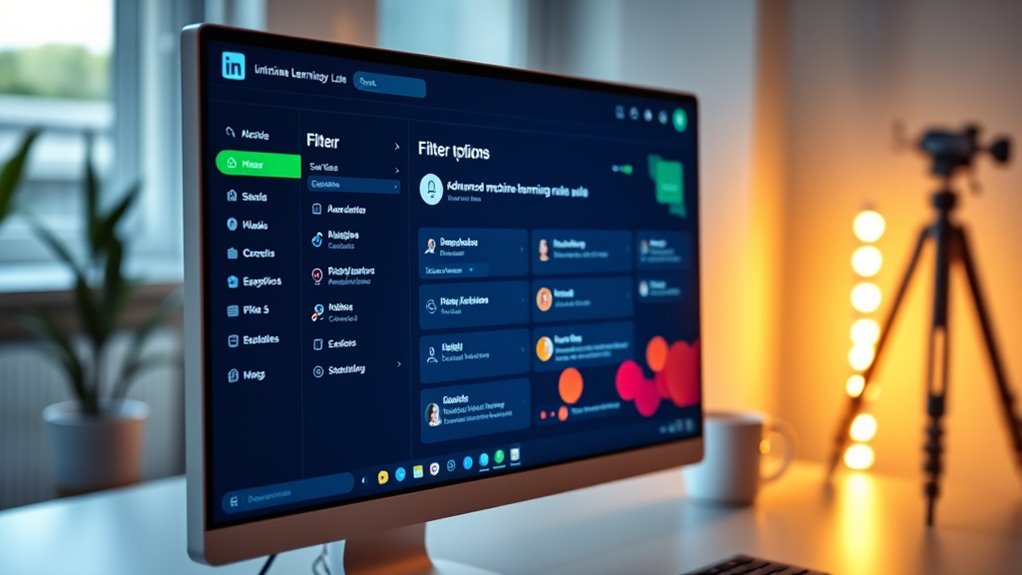Did you know that LinkedIn’s search filters can reveal machine-learning roles most people never see? Many overlook the power of combining advanced keywords, location preferences, and experience levels to uncover hidden opportunities. Mastering these techniques can give you an edge in competitive job markets, but there’s more to optimize than just basic searches. Curious how to access these secret filters and find roles tailored to your skills?
Key Takeaways
- Use Boolean operators like AND, OR, NOT to refine searches with specific keywords such as “machine learning” and “AI.”
- Apply experience level filters (entry-level, mid-senior) to find roles matching your career stage.
- Set location and remote filters to uncover geographically unrestricted or local opportunities.
- Filter by job type and company to target roles within preferred organizations and employment types.
- Combine all filters strategically to reveal hidden, highly relevant machine learning job opportunities.

Are you struggling to find the right machine learning roles on LinkedIn? If so, you’re not alone. Many job seekers overlook the power of LinkedIn filters, which can unearth hidden opportunities that aren’t easy to find through simple searches. These filters are strategic tools that help you narrow down roles tailored to your skills and career goals, especially in competitive fields like AI and data science. When you understand how to leverage these hidden filters, you’ll markedly improve your chances of landing a role that aligns with your expertise.
One of the most effective yet underutilized filters involves keywords related to AI interview prep and data scientist skills. Including specific keywords in your searches helps you target roles that demand those exact competencies. For instance, searching for roles with keywords like “machine learning,” “AI,” “deep learning,” or “data science” can surface opportunities that match your skill set. But don’t stop there—use Boolean operators like AND, OR, or NOT to narrow or broaden your search. Pairing “machine learning” AND “Python” filters out roles that don’t mention your preferred programming language, making your search more precise.
Use targeted keywords like machine learning, AI, and data science with Boolean operators to find precise roles.
Another valuable hidden filter is the “Experience Level” filter. Many people overlook this, but it’s vital for matching roles to your current skills. If you’re a recent graduate or transitioning from a different field, set the filter to entry-level or associate roles. Conversely, if you have several years of experience, target mid-senior or lead positions. Combining this with keyword filters ensures you’re only seeing relevant opportunities, saving you time and frustration.
Location-based filters also play a pivotal role, especially if you’re seeking remote work or specific geographic markets. You can set filters for remote roles or specific cities and regions. When combined with other filters, this helps you discover roles that aren’t widely advertised but are perfect fits for your preferences. Moreover, LinkedIn’s “Job Type” filter allows you to choose between full-time, part-time, contract, or freelance roles, aligning your search with your availability and career plans.
Lastly, explore the “Company” filter to target specific organizations known for their innovative AI projects or strong data science teams. Searching within particular companies that align with your career aspirations can reveal roles not visible in broader searches. When you combine these filters—keywords, experience level, location, job type, and company—you create a tailored search that surfaces those hidden machine learning opportunities, giving you an edge over other applicants.
Additionally, understanding Fundamentals of SQA can help you appreciate the importance of quality standards and testing processes, which are increasingly integrated into AI and machine learning projects to ensure reliable and accurate results.
Conclusion
By mastering these LinkedIn filters, you’ll uncover hidden machine learning opportunities that others might miss. Narrow your search with strategic keywords, experience levels, and location preferences, and you’ll stay ahead of the curve. Remember, “fortune favors the bold,” so don’t be afraid to dig deeper. With a little effort and smart filtering, you’ll find roles perfectly aligned with your skills and goals—your next big move is just a click away.









